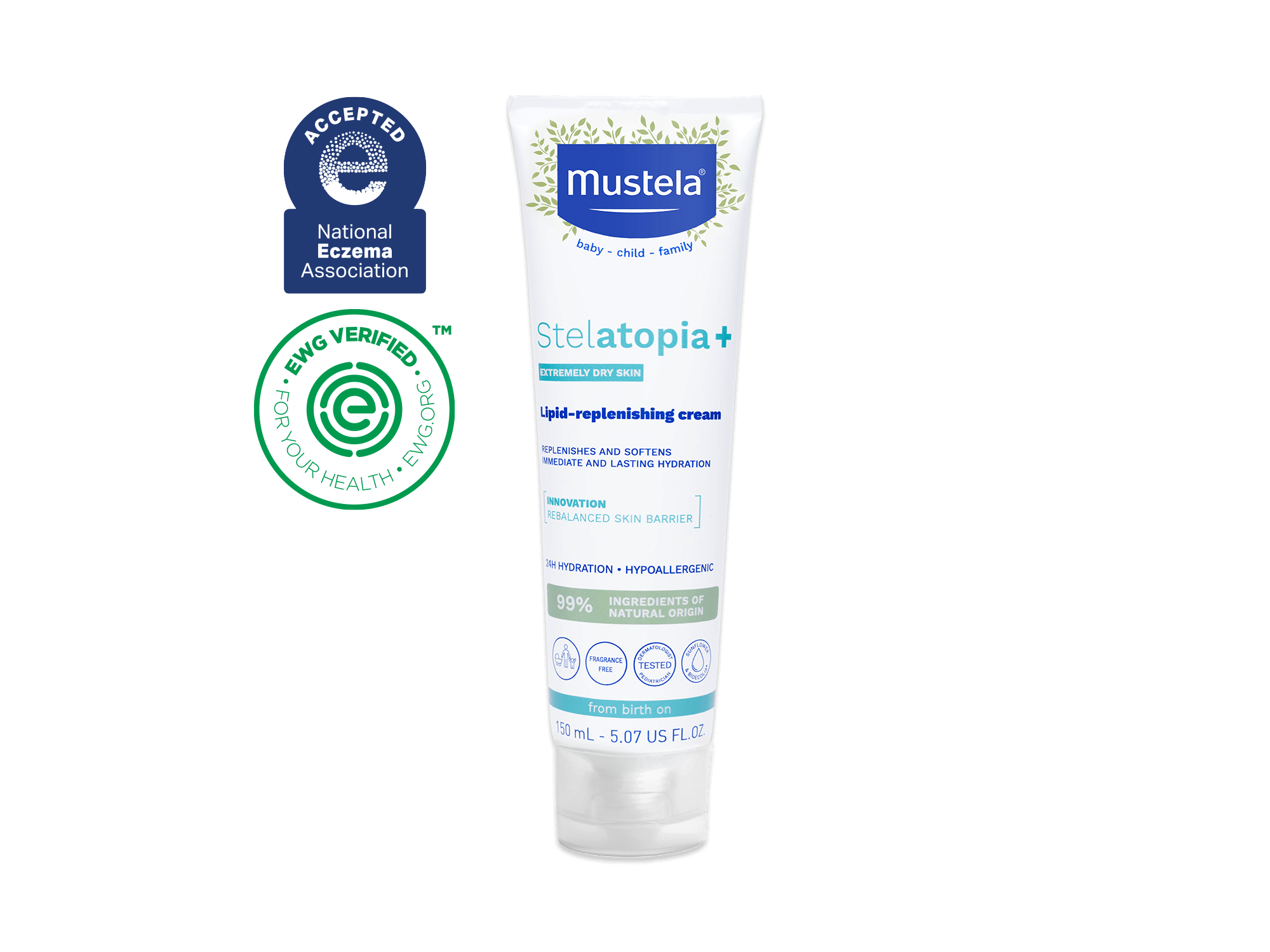Eczema (also known as atopic dermatitis), is extremely uncomfortable for your baby and can be caused by various—and sometimes surprising—factors. Because your baby’s skin won’t develop the same thickness and pH that your adult skin has for a number of years, their skin is naturally extra sensitive to rough fabrics, high temperatures, and even the nick of a fingernail.
In other words, what you may not even notice can irritate your baby’s skin, potentially leading to eczema flare-ups. Luckily, with proper care, this is something that can be treated and most often avoided.
If your baby does suffer from eczema, you will have to apply an emollient treatment at least once per day. However, even the emollient application may cause your baby discomfort. Luckily, our experts will show you five tips on how to apply emollients to your baby’s sensitive skin while reducing unnecessary discomfort.
Wash Your Hands

Washing your hands before applying an emollient product, like Mustela’s Stelatopia Emollient Cream, Stelatopia Intense Eczema Relief, or Stelatopia Emollient Face Cream, serves two purposes: it softens rough skin, and it removes any foreign substances like dirt, pollen, adult hand creams, and animal dander that can trigger an eczema flare-up.
And don’t just wash your hands with any old soap. The liquid or bar soap you’re used to washing with may be too much for your baby’s sensitive skin. Even the small amount left on your hands after rinsing can irritate the delicate pH balance of your baby’s skin, resulting in itching and swelling. Always choose a gentle hand soap that is free of harsh chemicals.
Trim Your Nails

We know you would never think of intentionally scratching your baby. But sometimes when you’re applying an emollient product, your baby can wiggle and cause you to nick them by mistake. Even a tiny scratch can lead to an eczema flare-up.
That’s why it’s so important that you check your nails before applying an emollient or any cream to your baby’s skin. Please don’t take this as a recommendation to cut your nails every time you apply an emollient cream or balm. Doing so is unnecessary.
Most of the time, you’ll just need to make sure your nails are short and that there are no sharp points or jagged edges. You may only need to trim them once or twice a week, but it doesn’t hurt to use an emery board more often to keep them smooth and dull.
When you trim or smooth your nails, it’s also a good idea to do the same to your baby’s fingernails. If their skin is itchy, they will likely try to scratch themselves, which can lead to a flare-up. Luckily, this can easily be prevented.
Remove Your Jewelry
As adults, we don’t think about how rough and sharp jewelry can be because it doesn’t bother our mature skin. But to a baby’s sensitive skin—especially skin prone to eczema flare-ups—a rough corner or a protruding clasp can feel like sandpaper.
We recommend removing any rings, and even bracelets, before applying an emollient product. This will ensure that nothing comes between your hands and your baby’s delicate skin.
Warm The Emollient Cream In Your Hands
Extreme temperatures can trigger an eczema flare-up in the same way that animal dander or scratchy fabrics can. Hence, it’s important to warm the emollient balm in your hands before rubbing it on your baby’s skin. When you think about it, your baby’s emollients and creams are often stored at room temperature. Depending on your preferences and the time of the year, that can range from 65 to 80℉.
Normal body temperature for a baby ranges from 97 to 100℉. So if we assume a body temperature of 98℉ and a cream temperature of 78℉, that’s a twenty-degree difference. Think about how twenty degrees feels to your mature skin (the difference between 58 ℉ and 38℉). Now imagine how it feels on your baby’s thin, sensitive skin. Brrr! A cream applied to their skin at room temperature could come as quite a shock.
To avoid possible flare-ups, we recommend warming the emollient cream in your hands for a few moments before rubbing it on your baby’s skin. Here are a couple of ways to do this:
- Hold a dollop of the emollient in your cupped hands for a minute or two.
- Squirt a generous amount of emollient onto your palm, and then rub your hands together for about 10 seconds.
Warming the cream before applying it to your baby’s skin is a small act of love that will help your little one stay comfortable despite their uncomfortable situation.
Apply The Emollient All Over Your Baby’s Body

Even if your baby’s eczema is restricted to a certain area, like their cheeks or wrists, be sure to apply the emollient all over their body. Don’t forget flare-up-prone areas like the backs of their knees and behind their ears. It’s best to apply the emollient at least once per day, but you can do it as often as you feel is necessary.
A typical application schedule might be once in the morning and once in the evening, but if you feel like your baby needs three, four, even five or more applications a day, that’s fine.
Expert tip: To help further relieve eczema-prone skin and prevent future flare-ups, dress your baby in Mustela's Stelatopia Skin Soothing Pajamas at nap time and before bed after applying emollient cream. Made with natural ingredients, these pajamas deliver skin-soothing moisture all night long so your baby can rest well.
And remember, you know your baby best. As your baby’s skin begins to produce its own hydrolipidic layer, you can decrease the number of applications to twice, or even once, per day. That’s good news for you and your baby.



















